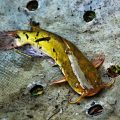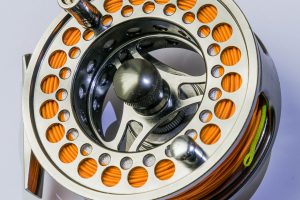Catfish digest food like most other fish. Catfish are usually omnivores, and their stomachs are designed to digest all kinds of food. The food that does not get digested leaves the body through the anal canal and into the water.
What do catfish eat?
There is no right answer to what catfish eat. Most of them are omnivores, meaning they eat plants as well as small living creatures. However, some are carnivores, some are herbivores, and some are even parasitic, which means they feed on other fish’s blood. The bottom line is that catfish are opportunistic eaters, which means they eat whatever is most abundant in the environment.
However, if you had to list down all the famous food items among catfish that most of them eat, you should see below. Here are some food items that your catfish will probably eat no matter where you get them from.
- Aquatic insects and other small insects
- Algae
- Commercial fish food like flakes and pellets
- Crayfish
- Small fish that fit into their mouths, like minnows
- Fish eggs
- Snails
- Phytoplankton
- Sea cucumber
- Seagrass
- Shrimps
These are some of the foods that you can use as bait to lure a catfish or feed it if you keep it as a pet. It is best to know what a specific species of catfish eats rather than every catfish, because it is very hard to generalize, considering how unique each species is.
Digestion of catfish food
The digestion of fish is very different from the digestion of food in humans. However, it does follow the same steps. The food goes in, gets used by the body, and the by-products of metabolism and undigested food leave the body.
When a catfish is carnivorous, it can eat still eat plants, but it will provide absolutely no nutritional value to the fish. Similarly, herbivores will not be able to digest a live animal, and it will instead be more harmful to them. Since most catfishes are omnivores, their digestive tract allows both plants and animals to pass through, get absorbed, and provide nutritional value to the fish. Needless to say, the most versatile diet is the omnivorous diet.
A fish’s digestive system contains the mouth, teeth, gill rakers, esophagus, stomach, pylorus, pancreatic tissue, liver, gallbladder, intestine, and anus. However, not every fish has all these parts, as carnivorous fish usually have teeth and a tongue to help them break down the food and swallow it. When it comes to herbivores don’t usually have teeth, and even if they do, the teeth are blunt. Omnivores can sometimes have teeth and sometimes not.
The stomachs of omnivorous and herbivorous fish are smaller in size compared to carnivorous ones as well. This is because they need less space to store the food. The food is then passed to the intestine, where it passes through the liver, where the food is stored as energy. Most of the energy absorption is done in the intestine. The food that was not useful is then expelled out of the body through the anus.
Food nutrients for catfish
There are some nutrients that all fishes need for their growth, immune systems, appearance, and much more. The main aim of eating food is to get these nutrients in adequate amounts so that they can lead a healthy life. These are some of the most important nutrients that the fish needs.
- Protein: Despite the diet of fish, it is very important. In fact, protein is the most important nutrient for producing enzymes, new body tissues, and energy. When the fish are young, a protein-filled diet is much more important to them than when they are older.
- Fatty acids: To store energy, fatty acids are required. However, too much fatty acid can be bad for the fish. Therefore, the diet of catfish should have fatty acids, but it has very few.
- Fat-soluble carotenoids: These are nutrients that are useful for giving fish body color and bright hues. If your fish is brightly colored, carotenoids will help it keep looking its best.
- Carbohydrates: This is another nutrient that is necessary for fish energy. Most commercial fish foods have a lot of carbohydrates. However, too many carbohydrates are bad for the fish, and protein is a better form of energy than this. If a fish eats too many carbohydrates, other useful nutrients might not get absorbed by it.
- Vitamins: The fish need vitamins very much to survive. Vitamins will help the fish fight off any diseases as they improve their immune systems. Moreover, vitamins also prevent stress in the fish, which is the number one cause of disease in fish.
- Minerals: Just like vitamins, minerals also improve the overall health of the fish, especially huge fish. Minerals improve the teeth, bones, and other tissue of catfish and other fishes. However, excessive minerals can be very harmful to the fish as well.
What is a catfish?
Catfish are a species of ray-finned fish that are known for their barbels or whiskers. There are more than 3,000 species of catfish found everywhere in the world except Antarctica. This means that they all have different mechanisms through which they survive. Catfish are very good at adapting to the environment.
Moreover, catfish have a pretty long lifespan as well, since, in the wild, they survive for 8 to 20 years! These fish also have Weberian apparatus, which allows them to hear underwater and even communicate with other catfish. This helps them warn others of predators and whatnot.
If you want to know how big some of the catfish get, you should know that the largest catfish ever caught was 646 pounds, and it was a Mekong giant catfish. The Mekong giant catfish is native to Thailand and can get as big as a dolphin. However, sadly, this fish is near extinction due to overfishing as it is one of the largest freshwater fish ever discovered.
Interestingly, if you compare the largest catfish to the smallest catfish, they won’t even seem like the same species! The smallest ever catfish is called the Asian stone mini catfish, and it gets only an inch big. This is a popular fish to keep in aquariums due to how easy it is to care for it and how peaceful it is. You can find these small fish mostly in Bangladesh and India.
In conclusion, catfish can eat a variety of foods as some of them are carnivores, others are herbivores, and most are omnivores. The digestive systems are different depending on the type of food the fish eats. However, they have a basic function that resembles each other. Digestion aims are the same in all fishes; to absorb the necessary nutrients.












Pingback: What Do Catfish Do for the Ecosystem? | Reel Fishing Guru